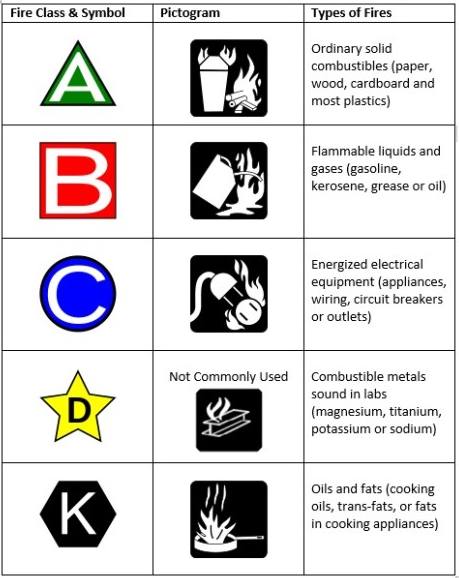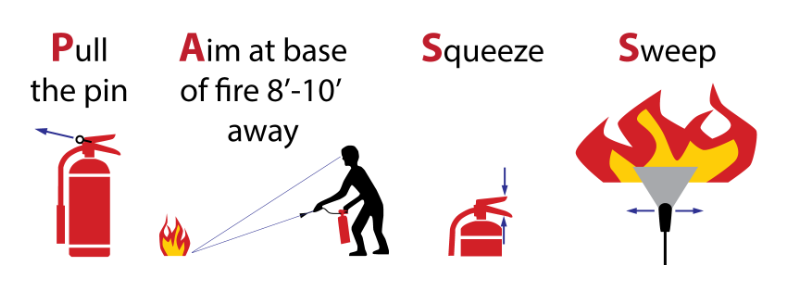How to Use a Fire Extinguisher
Fire can be devastating. If you find yourself in an emergency situation, knowing how to use a fire extinguisher could save your life!
The key aspects of putting out fires with these devices are pulling the pin and aiming its hose at either side before pressing down on levers or pumping handles, then sweeping across until any flames disappear from view (or continuing spraying once they’ve been adequately suppressed).
Choosing the right fire extinguisher
First, you should be aware of the different classifications of fires, then consider what types of fire you may encounter and choose an extinguisher accordingly. for this you need to understand Symbols on a Fire Extinguisher
How to identify best suitable Fire Extinguisher for fire?
- 👉 Class A – Ordinary combustibles Class fires can be caused by solid combustible materials which aren’t made of metals, including paper, wood textiles, textiles, and a few plastics. (Class A fires usually produce ash.) The background for the symbol is one of two colors: Metallic or Green If it’s the color.
Also Check : Class A Fire Extinguisher
- 👉 Class B – Combustible or flammable gases and liquids Class B fires include volatile or flammable liquids and gases like gasoline, diesel fuel, paints, thinners, and propane. (Class B fires usually contain liquids that bubble or boil.) Background of symbol could be Metallic or Red when it’s colored.
Also Check: Class B Fire Extinguisher
- 👉 Class C – Electricity that has been energized equipment So long as the equipment is “plugged in,” it could be considered a fire of class C. Examples of this include fires involving circuit breakers, fuse boxes equipment, and appliances and machinery. (Class C fires usually involve electricity.) The background can be Metallic or Blue If it is the color.
Also Check: Class c Fire Extinguisher
- 👉 Class D – Combustible Metals If you’re not working in a lab or an industry that makes use of the materials, it’s unlikely that you’ll be faced with an incident that falls under the classification of Class D.
Class D is caused by combustible metals like magnesium, sodium, potassium, and titanium. It requires special extinguishing agents (Metal-X foam) to stop a blaze. The symbol’s background will be one of two colors: Metallic or Yellow If it’s the color.
Also Check: Class D Fire Extinguisher
- 👉 Class K –Class K fires can be fueled with flammable liquids specific to cooking, such as vegetable or animal fat-based cooking oils and greases.These substances can ignite quickly if they reach high temperatures, as in the kitchen. Because of their flammability, they can quickly spread.
Also Check : Class K Fire Extinguisher
Steps to use a fire extinguisher
Once you have a basic understanding of the different kinds of fire extinguishers as well as their functions, you will operate them correctly.
One of the best ways to ensure that you are prepared in case of a fire emergency within your home is to learn the steps below and then review these regularly to safeguard your family and home.
Step 1. Find a clear escape route or exit
Before using the fire extinguisher, ensure you’ve got a clear route to the exit. If you cannot extinguish the flame, you’ll have to find a safe exit. Take this into consideration when choosing the best place to store the fire extinguisher, and ensure you have multiple ways to exit the area after you have retrieved it.
Step 2. stay back
The fire must be viewed from the side and stay back to the exit that you previously discovered. You must keep between 6 and 8 feet from the flames while you get ready to use the extinguisher for fires.
Step 3. Discharge extinguisher
It can be challenging to concentrate in an emergency, which is why the fire safety program has an established acronym to help you remember the steps to follow when operating the fire extinguisher.
If you’re extinguishing fires, it is recommended to take the following steps:
- P. Pull the pin of the flame extinguisher.
- A: Aim the extinguisher’s nozzle to the hose in a low position towards the bottom of the flame.
- S: squeeze the lever or handle to release the extinguisher.
- S: Sweep the nozzle around and back. Keep the fire extinguisher pointed at the bottom of the fire, and move it from the side opposite until the flames have been completely extinguished.
Step 4. Keep an eye on things
When the flames appear to be out, keep an eye on the fire area to make sure it doesn’t re-ignite. If the fire re-ignites, repeat the PASS procedure.
Step 5. Call the fire department
If you haven’t called the fire department yet, call them now. The firefighters will inspect the fire site and ensure it has been completely extinguished.
Step 6. Get to a safe place
As soon as the fire has been extinguished, or if you are unable to do so, leave the scene to a place out of the fire’s reach.
Maintaining fire extinguishers is important.
Make sure that citizens check the fire extinguishers for:
- Accessible in times of need – Check to see if anything impedes your ability to access it.
- The pressure level that is recommended – Many extinguishers have gauges that indicate when the pressure is excessive or too low.
- Working parts – Check that the hoses, cans, and nozzles aren’t damaged, broken, or rusted.
- Cleanliness – Get rid of the dust, oil, or grease on the exterior of the fire extinguisher.
- Guidelines and guidelines – Some extinguishers have to be shaken every month; others should be tested for pressure every couple of years.
Also Check : Kitchen Fire Extinguisher
Video Guide to Use a Fire Extinguisher
For Other information Visit our website : www.fire-extinguisher-guide.com
USA Goverment website : https://www.usfa.fema.gov/prevention/outreach/extinguishers.html

